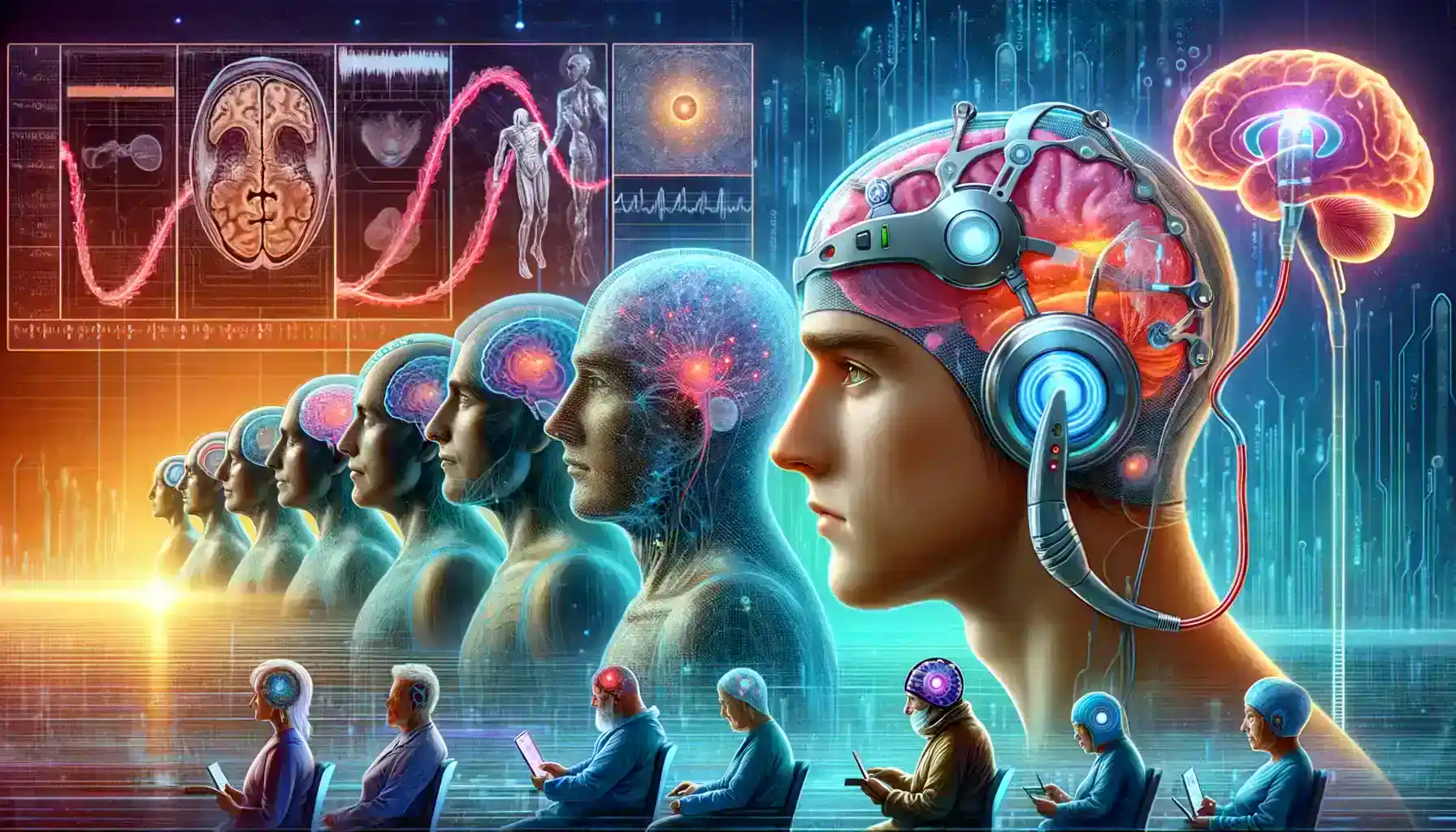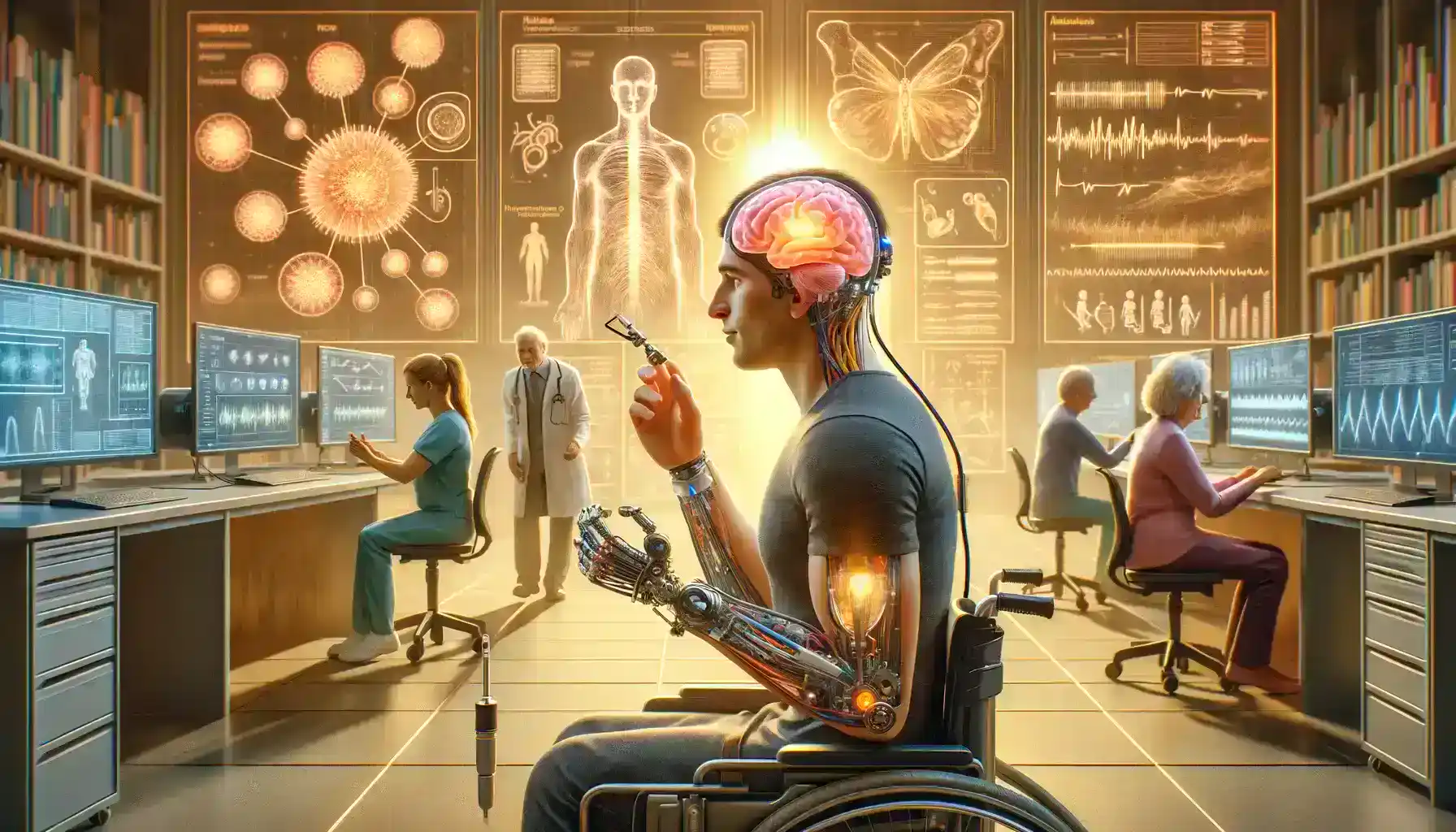Table of Contents
The domain of Brain-Computer Interfaces (BCIs) has witnessed groundbreaking advancements, especially in translating human thoughts into text. This article delves into the latest developments in this field, with a particular focus on non-invasive techniques that are reshaping communication paradigms.
In recent years, the convergence of neuroscience and artificial intelligence has propelled BCIs to the forefront of technological innovation. These interfaces have transcended the realm of science fiction, becoming a reality that holds immense promise for humanity.
This article delves into the latest developments in this field, with a particular focus on non-invasive techniques that are reshaping communication paradigms. As we explore the remarkable journey of Brain-Computer Interfaces(BCIs), we will uncover the transformative power they hold in enabling individuals to communicate, interact, and express themselves in ways previously unimaginable.
The Evolution of Brain-Computer Interfaces(BCIs)

The Evolution of BCIs has been nothing short of extraordinary, reflecting the relentless pursuit of enhancing human-machine communication. In its early stages, BCIs primarily relied on invasive methods that necessitated surgical implants. These pioneering efforts laid the foundation for what was to come, with early examples such as cochlear implants proving to be a lifeline for individuals with hearing loss. However, the invasive nature of these technologies presented limitations and risks.
In recent years, a remarkable shift has occurred in the field of Brain-Computer Interfaces(BCIs), marking a pivotal moment in their development. A significant Transition to Non-Invasive Methods has taken place, driven by advances in sensor technology and our growing understanding of brain signals. Non-invasive BCIs have emerged as a game-changer, eliminating the need for surgical interventions. Instead, they utilize external devices like EEG caps, which are placed on the scalp to capture neural signals. This transition has democratized access to BCIs, making them more accessible and less intimidating for users.
The move towards non-invasive Brain-Computer Interfaces(BCIs) represents a fundamental shift in the field, opening up new avenues for research, development, and application. As we explore the latest developments in non-invasive BCIs, it becomes evident that these technologies are not only reshaping communication paradigms but also fostering a more inclusive and user-friendly approach to human-computer interaction.
Non-Invasive Techniques
Electroencephalography (EEG): Electroencephalography (EEG) has emerged as a cornerstone in the field of Brain-Computer Interfaces (BCIs). These EEG-based Brain-Computer Interfaces(BCIs) operate by recording the electrical activity of the brain through electrodes strategically placed on the scalp. The electrodes pick up the faint electrical signals generated by neurons firing in the brain, and this data is then processed and analyzed by advanced algorithms. What makes EEG-based BCIs particularly remarkable is their non-invasive nature, as they eliminate the need for surgical procedures or implants, making them accessible to a wider range of users.
Functional Near-Infrared Spectroscopy (fNIRS): Functional Near-Infrared Spectroscopy (fNIRS) stands as a promising and emerging technique in the ever-evolving landscape of Brain-Computer Interfaces (BCIs). Unlike traditional BCIs that rely on electrodes placed on the scalp, fNIRS takes a different approach to measuring brain activity. This innovative method detects changes in blood flow in the brain by employing near-infrared light. When neurons in the brain become active, they require more oxygen, leading to increased blood flow to that region. fNIRS capitalizes on this physiological response, making it a non-invasive yet highly effective tool for monitoring brain activity.
AI Integration in BCIs
Machine Learning Algorithms:
Machine Learning(ML)Algorithms have emerged as the linchpin in the domain of Brain-Computer Interfaces (BCIs), enabling the translation of intricate neural signals into meaningful information. These algorithms are instrumental in decoding the complex language of the brain, offering a bridge between our thoughts and external communication. What makes them particularly remarkable is their capacity to discern subtle differences in neural patterns associated with various words or thoughts.
Imagine a scenario where an individual’s thoughts are translated into text or speech with remarkable accuracy. This feat is made possible by the capability of machine learning algorithms to distinguish between distinct neural patterns. For instance, these algorithms can identify the unique brain activity associated with thinking about different words or concepts. This means that, in practical terms, a BCI user can think about a word like “apple,” and the algorithm can recognize the corresponding neural signature, converting it into written text or audible speech.

Real-Time Processing:
Real-Time Processing powered by advanced AI marks a pivotal advancement in Brain-Computer Interfaces (BCIs), revolutionizing the way individuals with speech impairments communicate. This cutting-edge technology has the transformative capability to instantaneously translate thoughts into text or speech, offering a lifeline to those who have faced barriers to effective communication. One notable example that showcases the power of real-time processing is the groundbreaking work of researchers at Stanford University. They developed an AI system that, when coupled with Brain-Computer Interfaces(BCIs), enabled a paralyzed individual to communicate with remarkable effectiveness.
Imagine the profound impact of this technology on someone unable to speak due to paralysis or other speech-limiting conditions. With real-time processing, the delay between forming a thought and expressing it is virtually eliminated. As the user thinks, the AI system rapidly translates their thoughts into spoken words or written text, allowing for fluid and natural communication. This achievement not only enhances the quality of life for individuals facing speech impairments but also empowers them to engage more fully in social interactions, express their desires and needs, and participate actively in various aspects of life.
Breakthroughs in Thought-to-Text Translation
Case Studies: A Transformative Milestone
One of the most remarkable and transformative breakthroughs in the field of Brain-Computer Interfaces (BCIs) has been the successful demonstration of thought-to-text translation in individuals with severe speech impediments. These groundbreaking case studies have exemplified the potential of BCIs to profoundly impact the lives of those facing significant communication challenges. By providing individuals with a means to translate their thoughts directly into written text or spoken words, BCIs have effectively dismantled barriers to expression.
In several notable cases, individuals with conditions such as amyotrophic lateral sclerosis (ALS) or complete paralysis have been able to communicate fluently and effectively using BCIs. These case studies serve as powerful testaments to the capabilities of BCIs and the life-changing opportunities they offer to those in need. Moreover, they highlight the collaborative efforts of researchers, engineers, and individuals with disabilities, underscoring the importance of innovation and inclusivity in the development of assistive technologies.
Accuracy and Speed: Advancing Practicality and User-Friendliness
Another critical dimension of breakthroughs in thought-to-text translation lies in the continuous improvements in accuracy and speed. In the early stages of BCI development, accuracy could be a limiting factor, causing frustration for users attempting to convey their thoughts accurately. However, through relentless research and innovation, BCIs have seen substantial enhancements in their ability to precisely interpret neural signals and convert them into coherent text or speech. This increase in accuracy not only reduces errors but also boosts user confidence and satisfaction. Furthermore, Brain-Computer Interfaces(BCIs) have made significant strides in terms of speed, allowing for a more natural and seamless flow of communication.
The faster translation of thoughts into text or speech has made these systems more practical and user-friendly in real-world scenarios. Users can now engage in dynamic conversations, express their thoughts swiftly, and keep pace with the rapid exchanges of everyday communication. These advancements have not only improved the quality of life for individuals with speech impairments but have also expanded the potential applications of BCIs in various professional, social, and educational contexts.
Applications and Impact

Medical Applications: Medical Applications of Brain-Computer Interfaces (BCIs) represent a beacon of hope for individuals facing the challenges of stroke recovery and neurodegenerative diseases. BCIs have emerged as powerful tools in the field of rehabilitation, offering innovative solutions to address motor and communication impairments. For stroke victims, BCIs hold the promise of aiding in the recovery process by facilitating neuroplasticity and motor skill reacquisition. By allowing individuals to control external devices or prosthetics through neural signals, BCIs enable stroke survivors to regain mobility and independence.
Moreover, for individuals grappling with neurodegenerative diseases such as Parkinson’s or amyotrophic lateral sclerosis (ALS), BCIs offer a lifeline by providing a means of communication when traditional methods fail. These medical applications signify a profound shift in how we approach rehabilitation and care for those with neurological conditions. BCIs not only enhance the quality of life for patients but also pave the way for personalized and effective therapeutic interventions, bringing new hope to those on the journey toward recovery and improved well-being.
Enhancing Communication: Enhancing Communication for individuals grappling with conditions like Amyotrophic Lateral Sclerosis (ALS) represents one of the most profound and life-changing applications of Brain-Computer Interfaces (BCIs). ALS is a devastating disease that gradually robs individuals of their ability to move, speak, and communicate. In the face of such challenges, BCIs emerge as beacons of hope. By translating thoughts into text or speech, BCIs effectively dismantle the communication barriers that ALS imposes. These individuals, often trapped within their bodies, can now express their thoughts, feelings, and needs with remarkable fluency and precision.
The transformative impact of BCIs in this context cannot be overstated; they offer a lifeline of connection to the outside world, enabling individuals to engage in conversations, make choices, and regain a sense of agency and independence. The ability to communicate effectively is not merely a convenience but a fundamental human right, and BCIs are revolutionizing the landscape for individuals who have long yearned for a means to express themselves and connect with their loved ones, caregivers, and the world at large.
Challenges and Future Directions
Ethical and Privacy Concerns: As Brain-Computer Interfaces(BCIs) become more advanced, they raise important questions about privacy and the ethical use of thought data.
Technological Limitations: Current limitations include the need for more accurate and faster interpretation of complex neural signals.
Future Innovations: Ongoing research focuses on enhancing the portability, affordability, and user-friendliness of BCIs.
Conclusion
The advancements in non-invasive Brain-Computer Interfaces(BCIs), especially in translating thoughts into text, mark a significant leap in technology and healthcare. As we continue to refine these interfaces, they promise not only to revolutionize communication for those with impairments but also to offer profound insights into the workings of the human brain. The future of BCIs holds limitless potential, bridging gaps between the human mind and the external world through the power of technology.